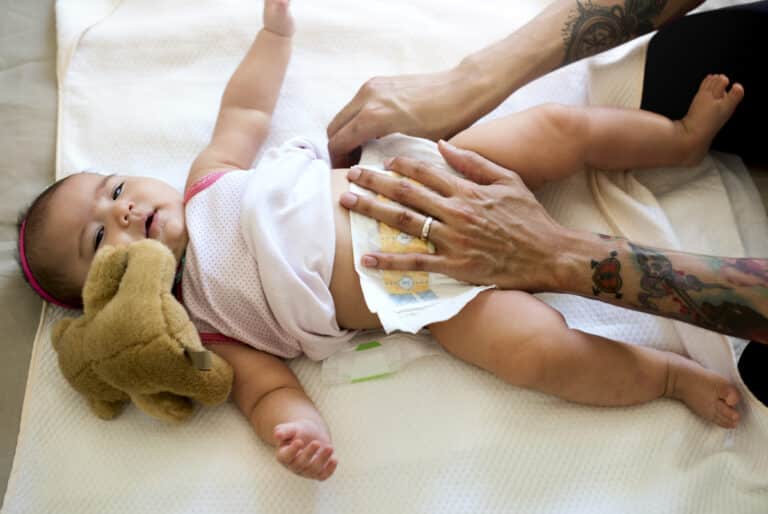For many parents, winter is the time of year when they are concerned about keeping their baby’s hands and feet’s warm at night. It can be difficult to find a way to keep your child’s hands warm during cold nights. And without having them wear too many clothes or cover up with blankets that could accidentally suffocate them.
Babies need their hands and feet to be warm at all times, especially during the night. Keeping your baby warm can not only make them happier during the night, but it can also keep their little immune system stronger. As a parent, you have a few different options when it comes to keeping your baby warm at night. You can put socks on their hands, you can use a sleeping bag with mittens attached, or you can buy special gloves that are made for babies. Here are a few tips on how to keep your baby’s hands or feet warm while they sleep.
In This Article
How do you keep baby’s hands warm?
As winter approaches, it’s important to take precautions with your baby. The cold season is here and it can be difficult for them to regulate their body temperature. For this reason, there are some steps you can take in order keep your baby warm at night without having to use more blankets than they need. There are a few different ways that you can keep your baby’s feet and hands warm at night.
Use Mittens:
Baby mittens are a great way to keep your baby’s warm at night. In the winter season, cold hands and feet are a common problem. Mittens can help to keep your infants hands and feet warm by trapping the heat in. Make sure that the mittens you buy for your baby are made of soft, non-itchy material so that they don’t cause any irritation.
How to use it:
Step:1 Place the mittens on your baby feet’s and hands.
Step:2 Roll the top half of the opening down over their hands and secure it with a button, velcro, or zipper depending on your preference.
Step:3 If you choose to, you can also add a layer of socks over the mittens for extra warmth.
Step: 4 Check the mittens periodically to make sure they are still on your baby feet’s or hands and that the fabric hasn’t shifted.
Use polyester fleece sleep sacks:
One way to keep your baby warm at night is to put them in a sleep sack. There are different types of sleep sacks made out of different materials. Polyester sleep sacks are a good option because they will keep your baby’s body heat in while they sleep. Sleep sacks come in a large range of sizes, from preemie to toddler. They also come with long sleeves and short sleeves for different weather conditions. So make sure about the sleep sacks while choosing for your baby.
How to use it:
Step 1: Firstly, wash and dry your fleece sleep sack in the washing machine.
Step 2: Place your baby’s leg into a long sleeve bodysuit, followed by a pair of underwear. Then, you need to place their hands in the armholes for them to be covered when they are inside the sleep sack. You can choose the size of the armholes based on your baby’s age.
Step 3: Then, you need to zip up the sleep sack around their body. You should make sure that their neck is covered with the sleep sack before you fasten it at the bottom. This will keep them warm throughout the night.
Step 4: Lastly, tuck the feet part of the sleep sack underneath your baby’s sheet.
Use a sleeping bag:
If you don’t want to use a sleep sack, you can also use a sleeping bag. Sleeping bags are made out of different materials, such as cotton or polyester. For cold air drafts, using a sleeping bag is a great way to keep your baby’s room heat in. Sleeping bags come in different weights, so you can find one that is appropriate for the season.
How to use it:
Step 1: Choose the appropriate sleeping bag weight for the season.
Step 2: Zip up the sleeping bag, and make sure that no cold air can get in. If needed, use an extra blanket on top of your sleeping bag for extra warmth.
Step 3: Tuck the bottom of the bag snugly around your infants feet.
Step 4: If needed, pull the bag up over your baby’s shoulders to keep baby warm at night.
Use a wearable blanket:
If you don’t want to use a sleep sack or sleeping bag, you can also use a wearable blanket. A wearable blanket is a blanket that wraps around your baby’s body and fastens with snaps or Velcro. This type of blanket can maintain the body temperature of your baby. And it’s also best to use for diseases like sudden infant death syndrome, etc. Baby’s cold hands and feet can be covered and it’s very convenient for parents to take care of their babies.
How to use it:
Step 1: Lay down your baby on its back on a flat surface.
Step 2: Place the blanket over your baby, with the bottom half of the blanket extending down to cover your baby feet.
Step 3: Fasten the snaps or Velcro around your baby’s waist.
Step 4: If you’re using a blanket with sleeves, fasten the snaps or Velcro around your baby’s arms.
Step 5: If you want, you can also wrap your baby with a light-receiving blanket before putting on the blanket. This is purely optional and depends on how warmly your baby feels about its situation.
Swaddle your baby:
Swaddling is a popular technique for helping babies sleep. It involves wrapping your baby in a light blanket so that its arms and legs are securely tucked in. Swaddling can help your baby to feel secure and warm. You can also use a hot water bottle on their feet which will help them to have a better sleep at night.
How to do it:
Step 1: Lay a blanket on a bed or other flat surface.
Step 2: Place your infant face-up on the blanket.
Step 3: Fold one of the bottom corners of the blanket over your baby’s body so that its legs are covered to just below its hips, with both legs bent slightly toward its chest.
Step 4: Bring the bottom of the blanket up to your baby’s chest, and tuck it securely under its armpits.
Step 5: Take the top of the blanket and fold it down over your baby’s body, tucking it in securely at the waist.
Tips we should know
Here are some common guidelines for keeping a baby warm at night. On frigid winter nights keep the baby stay warm is important for better infant sleep.
- Always place infants on their backs to sleep, to reduce the risk of SIDS (Sudden Infant Death Syndrome).
- Bundle up the baby in comfortable clothes like long sleeve cotton romper and keep a light blanket nearby to cover them if they get cold.
- Dress baby in one more layer than you are wearing.
- If the baby is too cold, you can use a hat. But don’t cover his head with bedding or any other material while he sleeps.
- Place the baby in a crib or bassinet that meets current safety standards.
- Put the baby to sleep on her back in a bare-bottomed crib with no pillows, loose sheets, quilts, comforters, or sheepskins.
- Use a pacifier at nap time and bedtime if the baby will take one.
- Avoid letting the baby get too hot. A too-warm environment can lead to problems such as SIDS.
- Use a space heater in the baby’s room, but make sure it is placed safely away from anything that could ignite it, such as curtains.
- Never smoke in the house–or anywhere near the baby.
- Breastfeed the baby if you can. Exclusive breastfeeding for the first six months of life is best for the baby’s health.
- Make sure your home is properly heated and insulated.
Even with all of these tips, some babies just can’t seem to stay warm at night. If your baby is one of these, you may need to seek advice from your pediatrician.
The Conclusion!!
When it comes to keeping your baby’s hands or feet’s warm at night, there are many options. You can use a heated mattress pad or even just an electric blanket that you put on the bed and then cover with blankets for warmth. Babies’ hands are important because they help regulate their body temperature by sending heat from their fingers up into the rest of their bodies.
Therefore, they also need to explore objects around them by putting things in their mouths. Making sure these tiny appendages stay warm is essential for babies who will be learning how to do more things themselves as they grow older. We hope you found this article informative and helpful. If your baby is always waking up to cold hands at night so use these ways to keep those little fingers warm.








![Home Renovation Guide [2025]](/app/uploads/2021/04/design-hacks-1-378x300.jpg)


